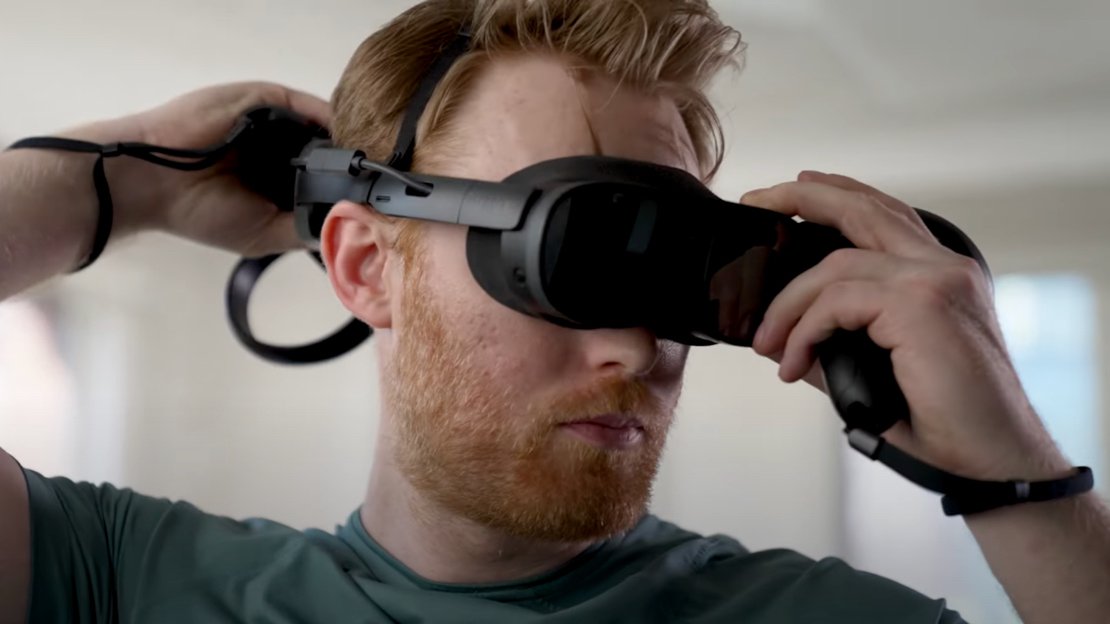VR Therapy: The Ultimate Guide to VR's Benefits and Applications for Patient Care
Learn how VR is reshaping the world of therapy and the impact on patients and clinicians

Healthcare | Collaboration | Training/Simulation | Article
7 min read
Virtual reality is transforming multiple fields and industries, with some of the most compelling use cases occurring in the world of healthcare. Occupational and physical therapists, as well as psychologists and other mental health professionals, are adopting VR therapy to enhance, gamify, and in some instances, even speed up healing for patients with conditions ranging from depression to chronic back pain. In this guide, you’ll find an overview of VR therapy , why it works so well for so many patients, and various applications.

Dave Rawlins
COO
MyndVR

Erica Kaitz
VP of Behavioral Health
Amelia Virtual Care

Patrick Murta
Chief Technology Officer
BehaVR
What Is VR Therapy?
VR therapy is a new approach to therapeutic treatment that uses virtual reality technology to facilitate rehabilitative exercises. The term “ VR therapy ” does apply in the broadest sense, meaning it can be used across various settings, including occupational, physical, and various forms of talk therapy, and can be customized for a diverse set of populations, such as people with specific illnesses, older adults, veterans, or young children.
As an example, VR is being used to manage disorders like Alzheimer's and dementia, particularly when it comes to
sundowning episodes
[1]
. “Sundowning is a neurological phenomenon that is common in people with dementia and refers to increased confusion or agitation at nightfall. Typical treatment for this usually involves antipsychotic drugs, which is obviously not something we want to see. What we found is that using VR is a very helpful way to distract, and meditate and calm a patient down potentially even before that sundown,” explains Dave Rawlins, Chief Operating Officer at
MyndVR
, which provides VR treatment solutions geared specifically toward older populations. Rawlins says that he is hopeful that VR can one day replace the use of antipsychotic medications as a more affordable and effective way to manage sundowning.
Another use case of VR therapy involves the treatment of neurological developmental disorders [2] , particularly among young adults and children, where interactive play is being used to enhance social skills and interaction with peers. These are just a few samples of the way in which VR can be tailored on a patient-to-patient basis in order to provide customized treatment for a variety of conditions.
How VR Therapy Is Different From Traditional Therapy
By its very nature, VR is much more flexible, customizable, and immersive than traditional therapy. Depending on the treatment, the patient may not need to be in the same room as the therapist to go through the exercises, which increases accessibility. “The current healthcare system can’t scale to the needs that we have for behavioral and mental health. There are more people who need treatment than there are therapists. VR allows us to take the same science, the same therapeutic approach, and make it available in an asynchronous model,” says Patrick Murta, Chief Technology Officer at BehaVR . He is hopeful that by adopting VR, clinicians can better meet the growing demand for therapeutic care without stretching already limited resources.
Most of the limitations VR is facing, according to the experts we interviewed, have to do with logistics: Traditional therapy comes with clear sets of rules and regulations and is (for the most part) covered by insurance providers. VR therapy has yet to be codified and prescribed in the same way. Because technology moves faster than legislation, some providers may not be comfortable with adopting a treatment without clear-cut rules. That said, AppliedVR's recent
approval by the FDA
[3]
for its therapeutic chronic back pain program is a sign that legislators are catching up to the potential of VR.
Benefits of VR Therapy
Increased Accessibility
VR therapy is a powerful tool for providing greater access to treatment, especially for people with limited mobility [4] , who traditionally have a harder time traveling to and from a clinic. In addition, now that remote therapy sessions have become commonplace due to the COVID-19 pandemic, many more people can benefit from treatment in the comfort of their homes. VR therapy also provides patients with an opportunity to practice situational treatment that would traditionally require travel and expense, with exposure therapy [5] being a prime example. As Erica Kaitz, licensed clinical social worker and Vice President of Behavioral Health at Amelia Virtual Care , explains “With a VR headset, I can transport you anywhere.You put on a headset, and I can put you anywhere, right? I can put you on a plane, taking off 15 times in a single session.” For a patient battling aviophobia, this experience would be nearly impossible to recreate in real life.
Immersive Experiences Lead to Better Outcomes
"The power of immersion is really important in the therapeutic process because it intentionally creates a slow down so that patients can really consider what they've just experienced,” says Kaitz. “VR therapy allows for this immersive process to occur faster because the experience feels much more realistic.” Some research also points to reduced burnout [6] in patients following VR treatment versus those following a traditional therapeutic treatment, likely because the experience feels more tailored and realistic, so patients can move through exercises with less mental fatigue.
Enhanced Engagement and Motivation
In a study of multiple-sclerosis patients undergoing occupational therapy the dropout rate from the program for VR therapy was almost half that of the control group [7] using traditional therapy. Simply put, “People like it," Kaitz says, adding anecdotally that her patients seem more excited to participate in the session when VR is involved.
“This enthusiasm also has larger implications — the better adherence a patient has, the more likely they are to experience positive results,” she explains. In other words, these early studies show that patients sticking with VR treatment tend to move through their program faster and make better progress than peers in traditional therapy.
Aligned Incentives
Healthcare providers are increasingly shifting to value-based care models [8] in which they receive payment based on the results a patient achieves while in their care (instead of the number of patient visits). “Aligning the tools — our VR-based products — with those economic and business models is really critical," says Murta. VR therapy is naturally more goal-oriented and focused than traditional therapy and conducted in a way that makes tracking this progress easier. These qualities make it particularly well-suited for a value-based system.
Cost-Effective Solutions
Most conventional treatments are created with one specific condition in mind, which means they have a fairly narrow use case. As soon as a better treatment is developed, the older methodology and equipment may fall by the wayside. VR software, on the other hand, is endlessly customizable and applicable to a variety of patients with different conditions. When improvements are made, the software may require an update, but clinicians will not need to re-purchase an entire new program.
These benefits extend to healthcare training. In a survey conducted by HTC VIVE, 91% of respondents agreed that VR enhances education plans and helps coordinators be more effective. If you would like a more thorough discussion on VR in healthcare training, you can read the full survey results here .
To learn more about the many facets of VR therapy , read What Is VR Therapy next .
VR and Occupational Therapy
Occupational therapy helps people with long-term injuries or disabilities maintain or improve activities of daily living (such as walking or eating independently). VR therapy can be used to help patients navigate through a virtual environment that can be too costly or difficult to recreate in a clinic — for example, navigating a set of stairs, getting in and out of a shower/bath, or walking on an uneven path in a park.
It can also make the experience for patients more fun. Instead of doing the same repetitive movement over and over again, patients get to row a virtual kayak or play golf. In
one study
[9]
,
conventionally treated stroke survivors completed only 23 to 32 upper extremity movement repetitions during a standard session, while those using VR
produced 200 to 300 repetitions
[10]
, proving just how beneficial engagement and immersion can be for long-term outcomes. “It’s a lot easier for them to stay in the activity we’re doing when they’re immersed in a scenic beach environment or on the top of a mountain,” Kaitz explains.
To learn more about how VR is being used in occupational therapy, read The Role of Virtual Reality in Occupational Therapy in 2023.
VR and Physical Therapy
Attending physical therapy sessions can help patients regain range of motion and increase mobility after an injury or a medical procedure, yet 20% of patients stop attending physical therapy after the third session [11] , and 70% of patients fail to complete their full treatment program . VR therapy has shown a lot of promise in helping patients engage with their treatment through immersive, fun exercises. “You can transport anyone from a traditional therapy room to anything you want it to be,” says Rawlins of MyndVR. “In our case, we have an application called ‘Butterflies,’ which transports a person from the therapy room to a beautiful open meadow. The user has a net, and they can catch butterflies with the net.”
VR therapy patients tend to exercise longer, with more effort and a decreased awareness of pain, per a recent profile piece in The New York Times [12] . “The biggest thing we see underlying our optimism in this space is what we call ‘smiles on faces,’” Rawlins said. “When you see the impact VR can have on seniors who are isolated within a residential facility for 15 or 20 years, with limited options of travel…when you’re able to transport the resident from that site into something magical, frankly, it’s incredibly powerful.”
Patient data seems to corroborate this optimism. Those who receive VR therapy ranked their overall experience as 7.5 out of 10 in a recent study [13] .
Want to learn more about VR in the physical therapy space? Read Virtual Reality Physical Therapy: A New Frontier for Healing and Recovery.
Using VR to Treat Mental Health Disorders
The demand for effective and compassionate mental healthcare is more pressing than ever. More than 970 million [14] people worldwide have been diagnosed with a mental illness, which means the need to provide therapeutic solutions is greater than ever. VR is proving [15] to be one of the most efficient methods to do so. “We're using protocols and methodologies that have been around since the ‘70s as they relate to behavioral, mental health, and pain treatment, and we're bringing those solutions forward in a very scalable way," Murta of BehaVR says.
While the principles behind the treatments stay the same, the immersive nature of VR is improving effectiveness and helping patients break old patterns quicker. A recent study found that VR therapy solutions significantly reduce depression [16] compared to traditional therapy methods. Patient adherence is also improved, with one study showing [17] that over 95% of participants who utilized VR therapy attended at least five sessions more, with a median session attendance rate of five, a higher rate than groups that didn’t use VR.
Immersion is another important component of treatment for mental health disorders. VR is a more instantaneous method of treatment compared to the ‘pause, think, reflect’ method,” Kaitz says. “You’re doing the same thing, but you’re doing it with increased intensity, more color, and greater control.”
To learn more about the use of VR for mental health treatment, read Immersive Healing: VR Therapy for Depression and Its Transformative Potential next.
VR and Pain Management
More than one in five [18] American adults experience chronic pain. This near epidemic resulted in another as people turned to opioids [19] to manage constant unrelenting discomfort. Now, VR is providing a safe, effective, and drug-free alternative. The sheer ability to be able to transport to a new space for a while without leaving the room has been shown to reduce sensations of pain [20] in patients. Meanwhile, a 2011 study [21] found that VR-based treatment can reduce the procedural pain of severe burn victims by 35% to 50% when receiving wound care. In more recent developments, a review from 2020 [22] found that 67% of its surveyed studies demonstrated significantly reduced pain as a result of using VR in hospitals and clinics.
Chronic pain has also been shown to recede with VR-assisted physical therapy, leading to AppliedVR being approved by the FDA. Because managing chronic pain can be a life-long process, tracking a patient’s progress can feel particularly meaningful, providing a space to acknowledge improvements and setbacks. VR provides an unprecedented way to track patient movements during physical therapy exercises, which makes it especially helpful for feedback. “In our application, not only can the physical therapists simulate ranges of motion, they can measure that range of motion as well,” Rawlins said. “And they can see exactly how far that patient can move, how many butterflies they can catch, in a certain period of time. So not only do you get the transportation effects and the distraction effect, but you also get this measurement effect. This is very crucial, as we all know data is increasingly important for all healthcare settings.”
To learn more about VR in pain management, read How is VR used for Pain Management?
HTC VIVE and VR Therapy
HTC VIVE works behind the scenes to make VR healthcare applications more effective, engaging, immersive, and accessible. We partnered with innovative healthcare companies to create solutions that scale to meet the growing demand for high-quality, compassionate, and convenient care.
Contact us to learn more about what we do.
[1] A lzheimer’s Association , https://www.alz.org/help-support/caregiving/stages-behaviors/sleep-issues-sundowning
[2] Children on the Autism Spectrum and the Use of Virtual Reality for Supporting Social Skill , https://www.ncbi.nlm.nih.gov/pmc/articles/PMC8870236/
[3] Cision PR Newswire , https://www.prnewswire.com/news-releases/fda-grants-appliedvr-approval-for-first-virtual-reality-therapeutic-to-treat-chronic-low-back-pain-301426221.html
[4] Bureau of Transportation, https://www.bts.gov/travel-patterns-with-disabilities
[5] American Psychological Association, https://www.apa.org/ptsd-guideline/patients-and-families/exposure-therapy
[6] Turkish Journal of Physical Medicine and Rehabilitation , https://www.ftrdergisi.com/abstract.php?id=4159
[7] Multiple Sclerosis News Today , https://multiplesclerosisnewstoday.com/news-posts/2023/01/16/virtual-reality-uses-physical-therapy-ms-may-aid-adherence/
[8] The Commonwealth Fund , https://www.commonwealthfund.org/publications/explainer/2023/feb/value-based-care-what-it-is-why-its-needed
[9] Archives of Physical Medicine and Rehabilitation , https://www.archives-pmr.org/article/S0003-9993(18)30099-6/fulltext
[10] Florida Occupational Therapy Association , https://www.flota.org/index.php?option=com_dailyplanetblog&view=entry&year=2022&month=01&day=27&id=65:virtual-reality-in-occupational-therapy
[11] WebPT , https://www.webpt.com/blog/expectation-vs-reality-why-patients-really-drop-out-of-therapy
[12] The New York Times , https://www.nytimes.com/2021/04/21/health/virtual-reality-therapy.html
[13] National Library of Medicine , https://www.ncbi.nlm.nih.gov/pmc/articles/PMC8568393/
[14] Children's Hope Chest , https://www.hopechest.org/global-mental-health-statistics/#:~:text=Global%20Mental%20Health%20Statistics%20Overview,are%20attributable%20to%20mental%20disorders
[15] National Library of Medicine , https://www.ncbi.nlm.nih.gov/pmc/articles/PMC8568393/
[16] National Library of Medicine , https://www.nature.com/articles/s41598-023-31477-z
[17] ScienceDirect , https://www.sciencedirect.com/science/article/abs/pii/S0005796721000656?via%3Dihub#preview-section-abstract
[18] National Institues of Health , https://www.nih.gov/news-events/news-releases/nih-study-finds-high-rates-persistent-chronic-pain-among-us-adults
[19] National Institues of Health , https://irp.nih.gov/catalyst/26/5/opioid-addiction-and-chronic-pain
[20] National Institues of Health , https://heal.nih.gov/news/stories/virtual-reality
[21] National Institues of Health , https://www.ncbi.nlm.nih.gov/pmc/articles/PMC4465767/
[22] National Institues of Health , https://www.ncbi.nlm.nih.gov/pmc/articles/PMC7669439/